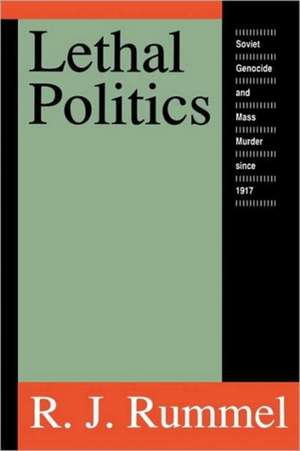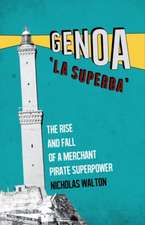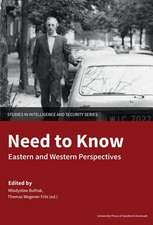Lethal Politics: Soviet Genocide and Mass Murder Since 1917
Autor R. J. Rummelen Limba Engleză Paperback – 30 ian 1990
Rummel divides the published estimates on which he bases his conclusions into eight historical periods, such as the Civil War, collectivization, and World War II. The estimates are further divided into agents of death, such as terrorism, deportations, and famine. Using statistical principles developed from more than 25 years of quantitative research on nations, he analyzes the estimates. In the collectivization period, for example, about 11,440,000 people were murdered. During World War II, while the Soviet Union had lost almost 20,000,000 in the war, the Party was killing even more of its citizens and foreigners-probably an additional 13,053,000. For each period, he defines, counts, and totals the sources of death. He shows that Soviet forced labor camps were the major engine of death, probably killing 39,464,000 prisoners overall.
To give meaning and depth to these figures, Rummel compares them to the death toll from'major wars, world disasters, global genocide, deaths from cancer and other diseases, and the like. In these and other ways, Rummel goes well beyond the bare bones of statistical analysis and tries to provide understanding of this incredible toll of human lives. Why were these people killed? What was the political and social context? How can we understand it? These and other questions are addressed in a compelling historical narrative.
This definitive book will be of interest to Soviet experts, those interested in the study of genocide and violence, peace researchers, and students of comparative politics and society. Written without jargon, its statistics are confined to appendixes, and the general reader can profitably read the book without losing the essence of the findings, which are selectively repeated in the narrative.
| Toate formatele și edițiile | Preț | Express |
|---|---|---|
| Paperback (1) | 436.14 lei 6-8 săpt. | |
| Taylor & Francis – 30 ian 1990 | 436.14 lei 6-8 săpt. | |
| Hardback (1) | 1000.30 lei 6-8 săpt. | |
| Taylor & Francis – 30 ian 1990 | 1000.30 lei 6-8 săpt. |
Preț: 436.14 lei
Nou
Puncte Express: 654
Preț estimativ în valută:
83.46€ • 87.54$ • 69.48£
83.46€ • 87.54$ • 69.48£
Carte tipărită la comandă
Livrare economică 01-15 aprilie
Preluare comenzi: 021 569.72.76
Specificații
ISBN-13: 9781560008873
ISBN-10: 1560008873
Pagini: 287
Dimensiuni: 152 x 229 x 22 mm
Greutate: 0.45 kg
Ediția:Revised
Editura: Taylor & Francis
Colecția Routledge
Locul publicării:Oxford, United Kingdom
ISBN-10: 1560008873
Pagini: 287
Dimensiuni: 152 x 229 x 22 mm
Greutate: 0.45 kg
Ediția:Revised
Editura: Taylor & Francis
Colecția Routledge
Locul publicării:Oxford, United Kingdom
Cuprins
I: Introdution; 1: Satanism as a Social Problem; II: Anthropological and Historical Perspectives on Satanism; 2: The Demonology of Satanism: An Anthropological View; 3: The Historical Satan; 4: Satanism: The New Cult Scare; III: The Satanic Threat to Children; 5: Satanism and Child Molestation: Constructing the Ritual Abuse Scare; 6: Endangered Children in Antisatanist Rhetoric; 7: Satanic Cults, Satanic Play: Is “Dungeons & Dragons” a Breeding Ground for the Devil?; IV: Psychiatry and Occult Survivors; 8: Occult Survivors: The Making of a Myth; 9: Satanism and Psychotherapy: A Rumor in Search of an Inquisition; V: Satanism and The Law; 10: The Police Model of Satanic Crime; 11: Law Enforcement and the Satanism-Crime Connection: A Survey of “Cult Cops”; 12: Satanism in the Courts: From Murder to Heavy Metal; VI: Rumor and News About Satanism; 13: The Dynamics of Rumor-Panics about Satanic Cults; 14: Accusations of Satanism and Racial Tensions in the Matamoros Cult Murders; 15: Devil Worship in Western Montana: A Case Study in Rumor Construction; 16: Caldrons Bubble, Satan's Trouble, but Witches Are Okay: Media Constructions of Satanism and Witchcraft; VII: The Satanists; 17: Legend-Trips and Satanism: Adolescents’ Ostensive Traditions as “Cult” Activity; 18: Social Construction from Within: Satan's Process
Descriere
While there are estimates of the number of people killed by Soviet authorities during particular episodes or campaigns, until now, no one has tried to calculate the complete human toll of Soviet genocides and mass murders since the revolution of 1917











